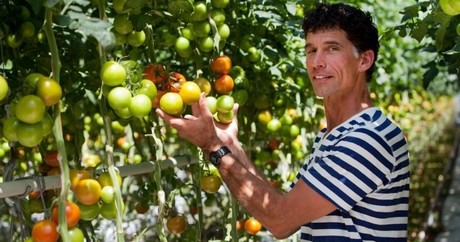In the hot summer of 2018, tomato grower Cock van Schie was forced to gain experience with a considerably increased sodium content. Fortunately, as a member of the guidance committee for sodium research in Bleiswijk, he was already used to such values. The crop did not suffer. "I don't get panicky that easily anymore," he tells Glastuinbouw Waterproof.
Full recirculation is only possible if the sodium content of the drain water remains within reasonable limits. “You are working towards a 0% discharge. For that you must first of all look critically at the sources. Some fertilizers contain a lot of sodium, and if you use tap water or osmosis water in addition to basin water, you have to pay attention to that. The next question is how high the content in the substrate may become,” says van Schie.
Together with his brother he grows tomatoes of the Mediax variety at two locations in Kwintsheul. He uses low-sodium fertilizers all year round and ensures that he does not take old drain water with a high sodium content to the new crop. If the sodium content increases, he will lower potassium sulfate and chlorine.
Exploring the boundaries
As a member of the supervisitory committee of research (BCO) he keeps a critical eye on the tests run by Wageningen University & Research in Bleiswijk, under the instructions of Wim Voogt and Chris Blok. These tests are twofold: on the one hand they explore the boundaries of various crops. On the other hand they test the storage of sodium in crops with a 'split-root' system. "We as BCO supervise the tests and judge the state of the crop," indicates Van Schie.
This year the test for tomato will be conducted on various levels, up to 25 mmol/l. "Even at higher concentrations we don't see much of a difference between treatments this year. The crops are looking good," he said.
Hot dry summer
Before even 8 to 9 mmol/l indicated would be enough to start treatment. "But last year - during the extreme drought - it got up to 15-17 mmol/l. That gave me quite a fright, luckily it started raining again not too long after so that we could start using basin water. But in the end we didn't notice a change in the crop," Van Schie said.
"Now I don't get as bothered by higher numbers. But that only applies to this breed; I do not know how other breeds react," he warns. This is also precisely the reason to continue the tests in Bleiswijk. For each crop and even breed the acceptable value will differ.
Split root
Another part of the research works with a 'split-root' system: two small gutters next to eachother. One with the normal nutrition, the other with drainwater with an increased level of sodium. The idea is that the crop will easily take up all the nutrition from the first gutter, while taking up the sodium from the second gutter and storing it. The extra stored part will have been removed from the water system. "It's interesting research, but it's still in such an early stage that it's hard to clearly conclude something that could be interesting in practice," Van Schie states.
Van Schie parts with a final tip: "If the absorption spontaniously increases, you will have to make it a bit easier for the plant. It already experiences an increased amount of stress due to higher salt levels. You have to let it grow, possibly even lower the EC temporarily to increase the ease of water intake."
